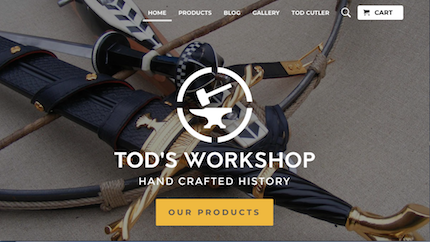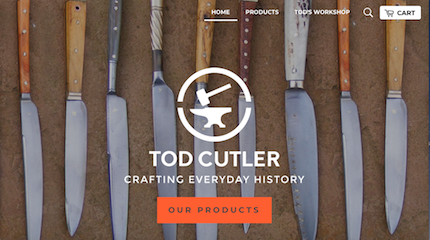Posts: 1,731 Location: Oxford, UK
Sat 27 Jan, 2018 1:46 am
Hi Guys,
Thanks very much for the positive feedback and thoughts.
There have been a few drivers behind all the changes that have been building for a few years and getting better images and a more streamlined system for both the user and Lou and I has been a large part of it.
Another aspect is how to divide my different work streams so it makes sense and that is where the custom/bespoke divide comes in.
Dealing with the easy things first.
Tod Cutler - basically everything that is not made by myself. This has some more expensive items like tricky to cast maces, but the push will be more and more to supply historically correct pieces at great prices. For example we now have a
rondel dagger that has a 'proper' sized grip rather than a mammoth grip, a single edged blade with a reinforced point and hollow fabricated steel rondels made from sheet and brazed together for £69/$97.
https://todcutler.com/collections/daggers-and-large-knives/products/15thc-rondel-dagger
Tods Workshop - Everything made by me.
In stock - These are items I have made and are sitting on the shelf ready to go out.
https://todsworkshop.com/collections/in-stock
Then we have the custom/bespoke debate and these two areas have been driven by my email load,
I will explain this as honestly as I can. There are a number of fairly standard products that I have made over the years that do not require much correspondence between the customer and myself to execute a lovely piece. For example a simple crossed and integrated scabbard for an Albion Senlac - belt length and colours pretty much cover it. However when this is put into emails and not all the information is supplied and then a couple of nicities about the current weather in Scotland and whether this should be worn over a gambeson and....and bam 10 emails is easily achieved. All of which either stop me actually making the piece or stop me being with my family. An 11pm finish on the emails is pretty normal for me.
However this site is also about the customer too. My current record is over 120 emails about a single simple piece. When it comes to me making that piece a few months down the line from the start of the email chain, I have to wade through 120 emails trying to extract the specification util it has gelled to what I believe to be the correct result and then I make that - the chance of it being fully correct is in fact diminished because there is simply too much correspondence. The conclusion is that for fairly straightforward projects even of a 'semi custom' nature it is better for both myself and my customers to standardise as much as possible and remove the email chain.
When the project actually requires that email interaction and the going back and forth then it falls into the 'custom' category on my site, so the time taken for the correspondence will be reflected in the price. For example the 120 email exchange was for a £600 product, so not for making the object itself, but for the correspondence alone it is £5 an email and somewhere out of that I have to actually make the project too - it was not working.
In a condensed form, time is money and I have to make a living and emails were taking up around 2-3 unpaid hours a day.
So back to the category name.
In the sword and knife world, we have 'custom makers', we buy 'custom knives', we do not have 'bespoke makers'. The power of Google is king and so I cannot be a 'bespoke knife maker'. So this means that the decision for my custom work was made and it cannot really be anything other than 'custom'.
For my 'semi-custom' work which is labelled as 'bespoke' is where the debate came as to what to call it and it raged long and hard. 'Semi-custom' is the obvious answer, but is not as universally known as 'custom'; 'modified' could work but is clunky and so on. These pieces are not cheap and so the customer requires some faith that I will make a great piece and part of that is to feel they are special, not just 'semi-secial' (you are all special!) and so we needed a category title that is a little more special and little less 'industrial' than 'semi-custom'. So we settled on 'bespoke' and although it is not quite correct in its usage is pretty close, sounds special and most people will not know that its usage is incorrect, they will just know that it means 'customised' if they know at all.
I hope that shows a little of the reasoning behind the new layout and the sector names, but please ask or comment as you wish and these are insights are very useful.
The response to the new site has been good so far and we plan to continue adding to the product lines rapidly in the next few months to
www.todcutler.com and of course new pieces get added to my in stock page on
www.todsworkshop.com fairly regularly.
Tod

